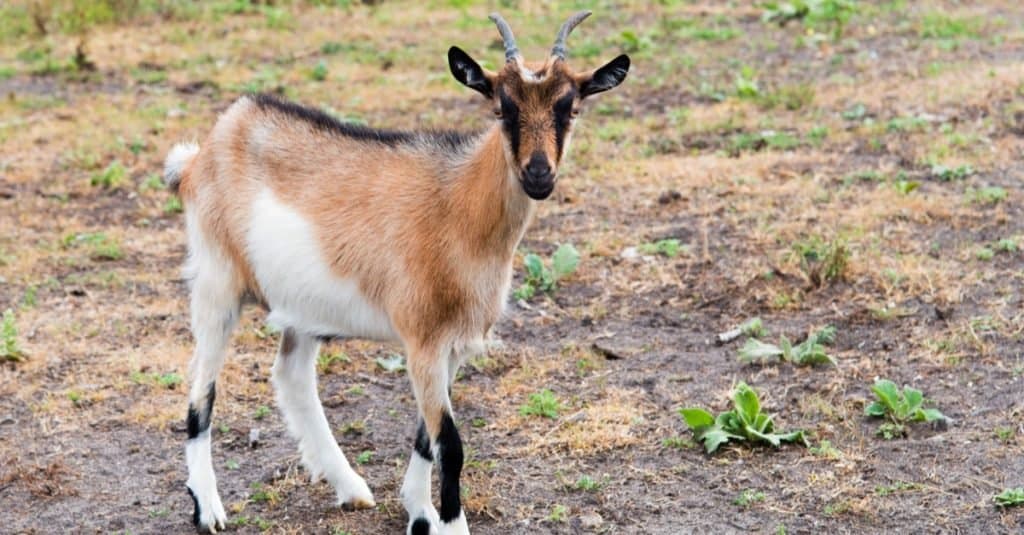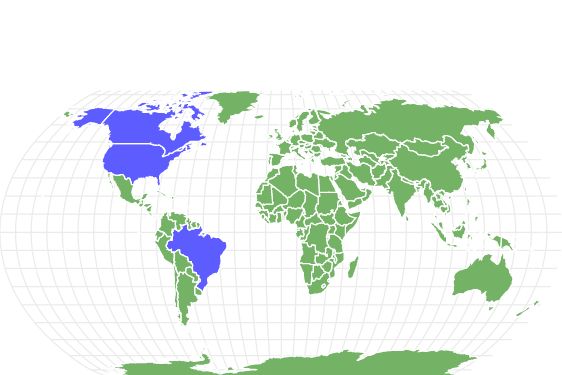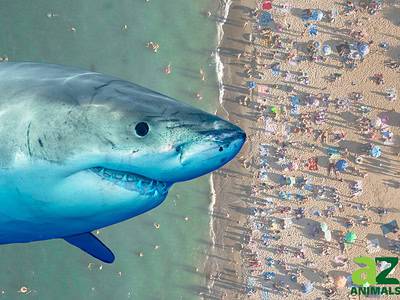Kinder Goat
Capra aegagrus hircus
Best jumper of all goats
Advertisement
Kinder Goat Scientific Classification
- Kingdom
- Animalia
- Phylum
- Chordata
- Class
- Mammalia
- Order
- Artiodactyla
- Family
- Bovidae
- Genus
- Capra
- Scientific Name
- Capra aegagrus hircus
Read our Complete Guide to Classification of Animals.
Kinder Goat Conservation Status
Kinder Goat Facts
- Name Of Young
- Kid
- Group Behavior
- Herd
- Fun Fact
- Best jumper of all goats
- Estimated Population Size
- 3000
- Biggest Threat
- Predators
- Most Distinctive Feature
- Black stripe on back
- Gestation Period
- 140 to 150 days
- Litter Size
- 3 or more
- Habitat
- Farms, pastures
- Diet for this Fish
- Herbivore
- Common Name
- Kinder goat
- Number Of Species
- 1
- Location
- U.S., Canada and Brazil
- Group
- Ungulate
Kinder Goat Physical Characteristics
- Color
- Brown
- Grey
- Black
- White
- Skin Type
- Hair
- Lifespan
- 15 years
- Weight
- 115 to 150lbs
- Height
- 2 to 3 feet
- Age of Sexual Maturity
- 4 to 10 months
- Age of Weaning
- 6 to 8 weeks
View all of the Kinder Goat images!
The kinder goat is a medium-sized goat with a laid-back, friendly temperament. Its high-fat, sweet milk and easygoing personality have made it a new favorite. It is the product of crossing an American pygmy with a Nubian goat.
The kinder goat is a relative newcomer to the world of domestic dairy goats. It first appeared in 1985.
The origin of the kinder goat is interesting. The Showalters, who are goat breeders at Zederkamm Farm in Snohomish, Washington, had two Nubian does but no Nubian buck to mate with them. Their Nubian buck had just died, and they didn’t want to bring outside bucks in to breed with their does. Finally, they decided to let their American pygmy buck mate with the Nubian does.
Although it took some maneuvering to let the little pygmy mate with the larger Nubian, the breeding was successful. About 150 days later, the first kinder goats were born.
The first kids had wonderful personalities and were excellent milk producers. Kinder goats create a lot of milk for their size, and their milk has a high-fat content. In 1986, the Showalters registered their new breed with the American Dairy Goat Association.
Since then, kinder goats have become increasingly popular for their sturdy, healthy build, easygoing personality, and high milk production.
5 Amazing Kinder Goat Facts!
- The milk of these goats can be as high as 7% butterfat. This is the highest fat content of any dairy goat. It is also high in milk solids, which are necessary for making cheese.
- Kinder goats frequently have multiple births. Triplets, quadruplets and even quintuplets are common among them.
- These goats are exceptionally healthy. They are resistant to many diseases that afflict goats, including parasites and goat pneumonia. A healthy kinder can live up to 15 years or longer.
- A kinder goat can produce about half a gallon of milk a day.
- These goats make excellent pets and are listed as one of the top 10 goat breeds for pets.
Kinder Goat Scientific Name
The kinder goat’s scientific name is Capra aegagrus hircus.
Kinder Goat Appearance and Behavior
These goats combine the slender legs of pygmy goats with the slightly stocky build of Nubians. They have long ears but not the noticeable “lop-eared” look of Nubians. Their ears stick out at the sides and are usually the same color as their fur.
They also combine the best personality traits of both breeds. They have the playful attitude of pygmy goats and the sociability of Nubians. They are intelligent, curious, and easy to train. These goats have sweet faces and easygoing personalities to match.
This may explain why one homesteader calls them, “the best goats you never heard of.”
A mature goat’s weight can range in size from 115 to 150 pounds. They have short, glossy coats and come in a variety of colors. The most common colors are reddish brown and dark brown. Most of these goats have a black stripe along their backs. They usually have striped or spotted faces.
A kinder goat’s horns are short and protrude backward from the head. The male’s horns are longer and have a slight curve.

©volofin/Shutterstock.com
Kinder Goat Habitat
These goats are farm animals who require places to graze and shelter from rain and cold. They do well in both hot and cold climates.
These goats are ideal for hobby farms and small homesteads because their small size and easygoing natures make them easy to handle. They prefer pastures where they can graze on weeds, shrubs, and brush.
These goats require good fencing. While all goats are escape artists, kinder goats may be the best jumpers of all goat breeds. High fencing will keep them in the pasture and help protect them from predators.
Because goats are playful, many goat owners build playgrounds for them where they can practice jumping and climbing.
Kinder Goat Diet
Like all goats, they enjoy foraging for brush, woody vegetation, and other natural foods. They also need fresh water and grass hay. The best diet for goats has 7% dietary crude protein and at least 50% dietary fiber.
Goats enjoy a varied diet and are willing to try anything. Healthy snacks for them include black oil sunflower seeds, vegetables, grapes, pears, watermelon, and other fruit.
Kinder Goat Predators and Threats
Domestic goats are always in danger from predators. Stray dogs, coyotes, bears, wolves, and cougars will prey on goats. Eagles and other raptors may carry off the baby goats.
Owning a kinder goat requires:
- Secure electric fencing.
- Nighttime shelter.
- Keeping the pasture clear of vegetation that can hide predators or materials that will attract them.
- A livestock guardian animal like a dog or a donkey.
Most goats are prone to parasites. They can also develop pneumonia if their coats get wet and cold. These goats, however, have strong resistance to both these common goat problems.
Kinder Goat Reproduction, Babies and Lifespan
These goats reach puberty at 4 to 10 months for females and 4 to 9 months for males. A billy can mate with up to 20 nannies or does a year. The goats have an average lifespan of 15 years.
Their gestation period lasts from 140 to 150 days, which is normal for most goats. Kinder nannies are excellent mothers who are highly protective of their kids.
Although kinders only have one breeding cycle each year, they are prolific breeders. It is common to have at least three kids in each birth or kidding. They can reproduce during their entire lifespan.
Kinder Goat Population
The Kinder Goat Breeders Association was established in 1986. By 2006, there were 3000 registered kinders in the United States. There are kinder goats in 13 U.S. states, Brazil and Canada.
Kinder Dwarf Goats vs. Nigerian Dwarf Goats: What Are the Differences and Similarities?
The Nigerian dwarf goat is a miniature dairy goat of West African origin. Most people regard the Nigerian goat as a pet goat. While it shares some similarities with the kinder goat, they are separate species. Following are the facts that highlight these differences and similarities.
What are the differences?
- Size: While kinder goats are 2 to 3 feet tall, dwarf goats are smaller. A male Nigerian dwarf is typically 1 to 1 ½ feet tall.
- Weight: A kinder goat weighs between 112 and 150 pounds on average, while the average weight of a Nigerian dwarf is 75 pounds.
- Ears: A kinder goat’s ears stick out from its head, and the Nigerian dwarf’s ears are almost straight.
- Purpose: Kinder goats are bred for milk, for meat and as pets. Nigerian dwarf goats are commonly used as pets, and a few people use them for milk.
- Origin: Breeders created the Nigerian goat dwarf from West African dwarf goats who were imported to the U.S. from 1930 to 1960. Kinder goats were bred by mating Nubian goats with American pygmy goats.
- Color: Although both goats come in the common goat colors, only Nigerian goat dwarfs show the occasional coat markings known as “moon spots.”
What similarities do they share?
- Milk: Both breeds produce high-quality milk with at least 7% butterfat.
- Temperament: Both breeds are playful, friendly and sociable.
- Coat: Both breeds have short coats.
- Horns: Both goats have long horns that curve backward.
Great Goats
These goats are strong, healthy, and easy to train. They produce excellent milk and have charming, playful temperaments. If you want a goat for a farm or for fun, a kinder goat is an excellent choice.
View all 77 animals that start with KKinder Goat FAQs (Frequently Asked Questions)
What Is a Kinder Goat?
A kinder goat is a dairy goat. It is a cross between an American pygmy and a Nubian goat.
What Are Kinder Goats Used For?
They are primarily used as dairy goats. Each kinder goat can produce a half-gallon of milk a day, and their milk is high in butterfat. They can also be used for meat, and some farmers use them for both.
Are Kinder Goats Good Pets?
Kinder goats are among the top 10 best goat breeds for pets, according to some goat experts. They are playful, intelligent, and sociable.
Kinder goats are docile enough to be around small children. They’re easy to train and handle. For these reasons, they make excellent pets.
How Big Are Kinder Goats?
Kinder goats fall squarely in the middle range of goat sizes. A typical kinder doe stands just over 2 feet tall, and a buck stands about 3 feet tall.
What are the Main Phenotypic Traits the Kinder Goat Is Known For?
- Long, slender legs and stocky bodies.
- Long ears that stick out from the side of the head.
- Rounded, sloping face shape.
- Black stripe down the back.
Thank you for reading! Have some feedback for us? Contact the AZ Animals editorial team.
Sources
- Domestic Animal Breeds / Accessed July 10, 2021
- New Life on a Homestead / Accessed July 10, 2021
- Simple Living Country Gal / Accessed July 10, 2021
- Open Sanctuary Project / Accessed July 10, 2021















